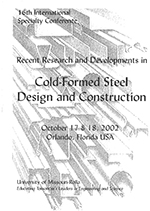Session Dates
17 Oct 2002
Abstract
A test program on cold-formed steel channels subjected to concentrated bearing load is presented in this paper. The web slenderness values of the channel specimens ranged from comparatively stocky webs of 15.3 to relatively more slender webs of 62.7. The tests were performed under end and interior loading conditions, and the test setup was different from the one specified in the North American Specification and the Australian/New Zealand Standard for cold-formed steel structures where the loading support is assumed free to rotate in the plane of the beam. The test specimens were seated on a fixed flat solid steel base plate, and a concentrated load was applied through a bearing plate to the top flange of the channels. The test setup closely simulated the floor joist members subjected to concentrated load. The test strengths are compared with the design strengths obtained using the North American Specification and the Australian/New Zealand Standard. It is concluded that the design strengths predicted by the North American Specification are generally conservative for end-two-flange and interior-two-flange loadings, and these design rules are shown to be reliable using reliability analysis. However, the design strengths predicted by the Australian/New Zealand Standard that is similar to the American Iron and Steel Institute Specification are generally unconservative.
Department(s)
Civil, Architectural and Environmental Engineering
Research Center/Lab(s)
Wei-Wen Yu Center for Cold-Formed Steel Structures
Meeting Name
16th International Specialty Conference on Cold-Formed Steel Structures
Publisher
University of Missouri--Rolla
Document Version
Final Version
Rights
© 2002 University of Missouri--Rolla, All rights reserved.
Document Type
Article - Conference proceedings
File Type
text
Language
English
Recommended Citation
Young, Ben and Hancock, Gregory J., "Design of Channels Subjected to Concentrated Bearing Load" (2002). CCFSS Proceedings of International Specialty Conference on Cold-Formed Steel Structures (1971 - 2018). 2.
https://scholarsmine.mst.edu/isccss/16iccfss/16iccfss-session3/2
Design of Channels Subjected to Concentrated Bearing Load
A test program on cold-formed steel channels subjected to concentrated bearing load is presented in this paper. The web slenderness values of the channel specimens ranged from comparatively stocky webs of 15.3 to relatively more slender webs of 62.7. The tests were performed under end and interior loading conditions, and the test setup was different from the one specified in the North American Specification and the Australian/New Zealand Standard for cold-formed steel structures where the loading support is assumed free to rotate in the plane of the beam. The test specimens were seated on a fixed flat solid steel base plate, and a concentrated load was applied through a bearing plate to the top flange of the channels. The test setup closely simulated the floor joist members subjected to concentrated load. The test strengths are compared with the design strengths obtained using the North American Specification and the Australian/New Zealand Standard. It is concluded that the design strengths predicted by the North American Specification are generally conservative for end-two-flange and interior-two-flange loadings, and these design rules are shown to be reliable using reliability analysis. However, the design strengths predicted by the Australian/New Zealand Standard that is similar to the American Iron and Steel Institute Specification are generally unconservative.



